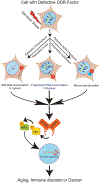Mechanistic link between DNA damage sensing, repairing and signaling factors and immune signaling
- PMID: 30798935
- PMCID: PMC7043287
- DOI: 10.1016/bs.apcsb.2018.11.004
Mechanistic link between DNA damage sensing, repairing and signaling factors and immune signaling
Abstract
Previously, DNA damage sensing, repairing and signaling machineries were thought to mainly suppress genomic instability in response to genotoxic stress. Emerging evidence indicates a crosstalk between DNA repair machinery and the immune system. In this chapter, we attempt to decipher the molecular choreography of how factors, including ATM, BRCA1, DNA-PK, FANCA/D2, MRE11, MUS81, NBS1, RAD51 and TREX1, of multiple DNA metabolic processes are directly or indirectly involved in suppressing cytosolic DNA sensing pathway-mediated immune signaling. We provide systematic details showing how different DDR factors' roles in modulating immune signaling are not direct, but are rather a consequence of their inherent ability to sense, repair and signal in response to DNA damage. Unexpectedly, most DDR factors negatively impact the immune system; that is, the immune system shows defective signaling if there are defects in DNA repair pathways. Thus, in addition to their known DNA repair and replication functions, DDR factors help prevent erroneous activation of immune signaling. A more precise understanding of the mechanisms by which different DDR factors function in immune signaling can be exploited to redirect the immune system for both preventing and treating autoimmunity, cellular senescence and cancer in humans.
Keywords: DDR; Genomic instability; Innate immunity; MRE11; Micronuclei; NBS1; RAD51; STING; Senescence; cGAS.
© 2019 Elsevier Inc. All rights reserved.
Figures


References
-
- Bakkenist CJ, & Kastan MB (2003). DNA damage activates ATM through intermolecular autophosphorylation and dimer dissociation. Nature, 421(6922), 499–506. - PubMed
Publication types
MeSH terms
Substances
Grants and funding
LinkOut - more resources
Full Text Sources
Research Materials
Miscellaneous

